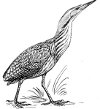The Wife of Bath's Prologue and Tale Contents
Part twenty: l.952 'Pardee, we wommen' - l.1004 'These olde folk'
Synopsis of l.952-1004
The Wife embeds her version of Midas and the ass's ears into the quest narrative
 The Wife interrupts the story to tell her own version of Ovid's tale of what happened when Midas was given the ears of an ass, as an example of women's inability to keep secrets. She resumes, describing how the Knight is sorrowful.
The Wife interrupts the story to tell her own version of Ovid's tale of what happened when Midas was given the ears of an ass, as an example of women's inability to keep secrets. She resumes, describing how the Knight is sorrowful.
There seems to be no solution to the Knight's quest. However, on the very day that he must return to the court with his answer he sees twenty-four ladies dancing. He approaches them for the wisdom that he has failed to find but they vanish, leaving only an ugly Old Woman to be seen. She asks him if she can help him in his quest.
Commentary on l.952-1004
l.951-82 wol ye heere the tale?: An embedded narrative is a story set within another story. Chaucer gets the Wife to tell the story of Midas and his ass's ears.
In Ovid's Metamorphoses, Midas is given ass's ears as a result of a dispute about music. He will not agree that Phoebus on his lyre plays more beautifully than Pan on his pipes, so Apollo gives him animal ears. He hides them with a purple tiara. Inevitably his barber notices; he can't contain himself and tells the secret to a hole in the ground. Reeds grow on the spot and tell the secret as the southern breeze rustles them.
The story is changed by Chaucer so that the Wife says that it was Midas' wife who betrayed his secret. The change to the story enables it to be connected to the Wife's asides as she tells the main tale. She has just commented that she doesn't think it worth anything to women to be praised for discretion. They can't help themselves, she claims; they can conceal nothing.
This confirms what we already know about the Wife's indiscretions from her Prologue, e.g. l.534, where the Wife tells us that she relates her husband's behaviour to her friend and to her niece, whether it's something embarrassing like urinating on a wall, or something serious that might cost him his life.
l.972 bitore: Chaucer uses the simile of the bittern, now a rare bird in England.
l.980 we kan no conseil hyde: The Wife interjects with her own (harsh) judgement about womankind.
l.982 Redeth ovyde: In charge of her own tale, the Wife casually tosses out an ‘auctoritee' to validate her narrative, just as Jankin once did to her.
l.990-2 a forest side, / … a daunce … / … ladyes foure and twenty: A set number of mysterious dancers in a woodland glade is a staple element of fairy tales.
l.998,1000 a wyf: Chaucer uses the word to mean ‘woman'. It's useful to understand this use of the word in Middle English, and it has implications for the meaning of the opening of the Wife's description in The General Prologue to the Canterbury Tales.
l.995-9 Vanysshed… / … A fouler wight: The metamorphism of dancing ladies into a foul old woman establishes the kind of story (genre) in which magical transformation will not be out of place. (see Narrative)
l.1004 Thise olde folk kan muchel thing: An attractive sentiment from the Wife who has commented on her own loss of youth.
Chaucer the poet
Using the flexibility of the iambic pentameter.
Read the section out aloud from l.969 ‘Doun to ... ‘ to l.980, ‘ Yet out ..'. Think of the effect of the way Chaucer disrupts the regular –x-x-x-x-x pattern of the iambic pentameter (see Chaucer's metre: Iambic pentameter):
- He places the stronger emphasis on the opening words of some of the lines, e.g. ‘Doun' , ‘Now', ‘Heer'
- This alerts the reader to a change: something new is happening. It points to the drama and excitement of the revelation.
Investigating l.952-1004
- Identify the passages in this section where you can see that Chaucer is making the Wife's voice and views apparent
- Which of the answers to the question in the Queen's challenge
- Does the Wife endorse?
- Does the Wife dismiss?
- How does the Wife's response to the answers link with what we know of her?
